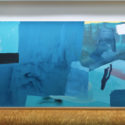As announced a few weeks ago, opened German visual artist and muralist Johannes Mundinger “Flurstück” his first big solo show in his hometown Offenburg in Germany.
The exhibition consists of a series of new works reflecting the artist’s own expression and visual language presented at the eight room gallery space of the Kunstverein Offenburg-Mittelbaden e.V., in the south-west of Germany with more than 30, mostly large-scale works.
The exhibition, which not only consists of large-scale paintings, we find works in which Johannes Mundinger explores the limits of the two-dimensional. Images with shadows, which can be seen in the back of the exhibition and which are extended by parts on the floor, become in many ways objects, like the three canvases hung unframed in the air and slightly resting on the floor.
Much of the same can be said of Mundinger’s work on paper that due the nature of the material cannot be smoothly attached to the walls of the gallery as well as the pieces painted directly on the wall.
When looking at Johannes Mundinger we notice a powerful serenity in his brushstroke that is hard to categorise, but that can in many ways be defined as a neo abstract expressionistic style, where shapes and colours express emotions, experiences and memories in a way that allow the viewer to project their own ideas, and derive their own meanings from it.
According to Johannes, much of his work is process based, both when it comes to big walls and smaller paintings. Only with rough sketches and a certain idea of what he wants to create, he develops each piece though an expressive flow based in feelings and abstracts ideas composition, elements he uses to see where they lead him to.
“Flurstück” that opened last month runs until the end of this month at Kunstverein Offenburg-Mittelbaden e.V. (Kulturforum an der Weingartenstraße) Amand-Goegg-Str. 2 | 77654 Offenburg, Germany.

Author: Fran
Founder and editor of Urbanite. Street Art lover who after the finishing her MA thesis on the Mexican and Norwegian muralist movement in the 1920-50s, developed a fascination for street art and graffiti that eventually led to collaborations with different art blogs, including the creation of this one.
















You must be logged in to post a comment.